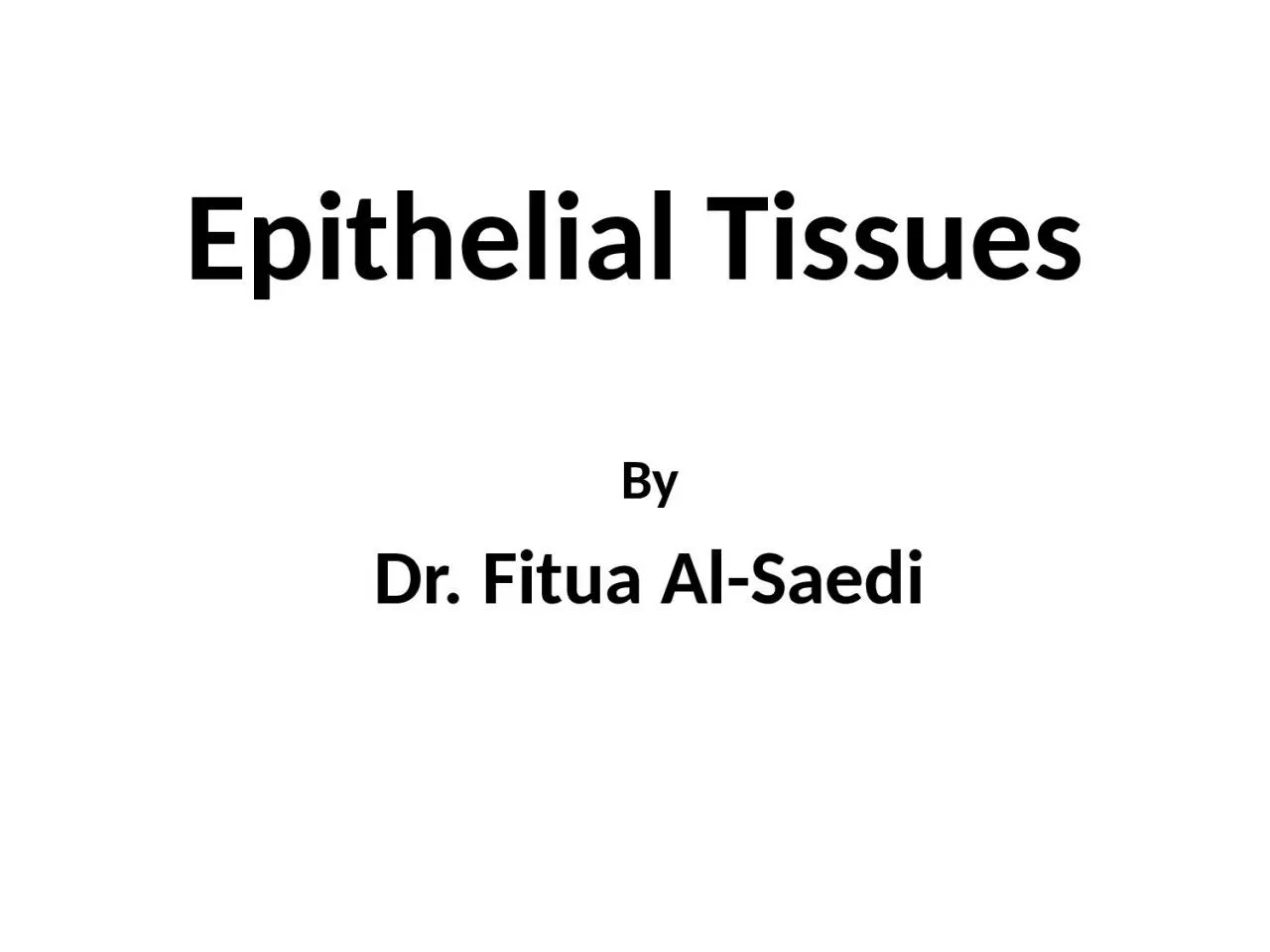

Fitua Al Saedi The human body is composed of four main types of tissues 1 Epithelial tissues 2 Connective tissues 3 Muscular tissues 4 Nervous tissues A ID: 920573
Download Presentation The PPT/PDF document "Epithelial Tissues By Dr." is the property of its rightful owner. Permission is granted to download and print the materials on this web site for personal, non-commercial use only, and to display it on your personal computer provided you do not modify the materials and that you retain all copyright notices contained in the materials. By downloading content from our website, you accept the terms of this agreement.
Slide1
Epithelial Tissues
By
Dr.
Fitua
Al-
Saedi
Slide2The
human
body is composed of four main types of tissues :
1. Epithelial tissues 2. Connective tissues3. Muscular tissues4. Nervous tissues
A tissue is a group of cells and their extracellular matrix that share the same embryonic origin and perform a similar function.
Tissue Definition
The study of animal tissues is called histology.
Histology
Slide3Epithelial Tissues
Epithelial tissues are essentially large sheets of cells covering
the internal and external surfaces of the body.Epithelia arise from all of the 3 primary germ layers: ectoderm (outer layer; e.g. skin & surface of sense organs), mesoderm (middle layer; e.g. lining of body cavities), and
endoderm (inner layer; e.g. internal linings of gastrointestinal & respiratory tracts).
Slide4General characteristics of epithelial cells and tissues
:
Polar:
Epithelial cells have structurally- and functionally-distinct apical and basal surfaces. The apical surface faces the external environment or lumen
while the basal surface faces the basement membrane.
Closely-connected continuous sheets:
Epithelial cells typically fit closely together, forming continuous sheets of tissue. The lateral surfaces of these cells interact through junctional complexes (adhering junctions, tight junctions, and desmosomes) and gap junctions
Slide5General characteristics of epithelial cells and tissues
:
Avascular:
Epithelial tissue does not contain blood vessels, with few exceptions (e.g. stria vascularis
of inner ear).
Supported by connective tissue:
Epithelia rely on support from underlying connective tissue, facilitated by a layer of extracellular matrix called a basement
membrane
.
Slide6Two
main types of epithelial tissues: A- Covering or lining
epitheliumB- Glandular epithelium Types of epithelial tissues
Slide7A. Covering or lining epithelium
They
are classified according to the number of structural layers into :Simple
epitheliumIs an epithelial tissue made up of only one layer of epithelial cells. These cells are in direct contact with the basement membrane
Stratified
epithelium
This type
of
epithelial
is
composed of more than one layer of
epithelial
cells. The basal layer is the only one that is in contact with the basal lamina
Slide81
. Simple epithelium includes:
a. Simple squamous epithelium: This type of tissues is found in the following parts in the body: ➢ lining the inside of the blood vessels [called: endothelium] ➢ lining the inside of the lung cavities [mesothelium] ➢ lining the inside of the mouth and esophagus b. Simple cuboidal epithelium: This type of tissues is found in the following parts in the body:
➢ lining the tubules within the kidney ➢ lining the ducts of many glands
Slide9d. Pseudostratified epithelium:
It
consists of many types of cells arranged in different levels and therefore it gives this tissue a pseudostratified shape.Non-ciliated
pseudostratified columnar epithelia are located in the membranous part of male vas deferens, while ciliated type of this tissue is found in the trachea.
c. Simple columnar epithelium: This type of tissues is lining the stomach and the intestines
1-
Simple epithelium includes
:
Slide102- Stratified epithelium
:
This type of epithelium consists of many cell layers. a. Stratified squamous epithelium:
There are two types of this tissue:1- Keratinized which is found in the skin (epidermis). 2- Non-keratinized which found in the mouth and vagina.
b. Stratified cuboidal epithelium:
This
type is found in the ducts of the glands.
Slide11c. Stratified columnar epithelium:
This type is found in the in conjunctiva
d. Transitional epithelium:
This type is found only in the urinary system.
2- Stratified epithelium:
Slide12Slide13B-Glandular epithelium (the glands):
Some epithelial cells may be specialized to perform a secretory
function.
Comprised of organized collections of secretory epithelial cells, glands (also called glandular epithelia) are broadly divided into two categories: endocrine (without ducts) & exocrine (with ducts). Endocrine Glands
release their secretions—called hormones—directly into the bloodstream for distribution to target tissues with specialized receptors.
Examples include the pituitary gland, the ovaries
& testes, and the pancreasExocrine
Glands
release
their secretions into a lumen
through an epithelial-lined tube called a duct
Examples include
salivary glands &
sweat glands
Slide14While most exocrine glands are
multicellular, goblet cells
are the only example of unicellular exocrine glands in mammals. They can be found in the epithelium lining of the intestines.These specialized epithelial cells secrete mucus are typically found in simple and pseudostratified columnar membranes
~~~ Exocrine Glands
Goblet cell
Slide15Protection
Epithelia provide a layer of protection
for all
underlying tissues from toxins, pathogens, etc.
e.g. stratified squamous keratinized epithelium of the skin
Absorption and/or Secretion
Depending on the location, some epithelia are involved in absorption or
secretion
e.g. simple cuboidal epithelium of the choroid plexus
Motility
Some epithelia have motile cilia on their apical surface that move in coordinated waves to move particles (e.g. mucus)
e.g. ciliated pseudostratified columnar epithelium of the
trachea
Sensation
e.g
. stratified squamous non-keratinized epithelium of the cornea
Function of epithelial tissues
Slide16Thank you for your attention